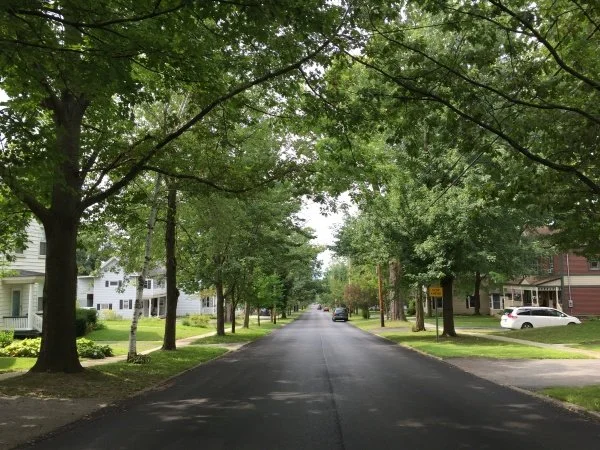One Tree Planted sponsors 200 trees at Ethan Allen Homestead
photo courtesy of the Vermont Agency of Natural Resources
The soil breaks apart like cake as I carve a pit about as wide and deep as my shovel on a stretch of earth along the Winooski River. I hover a silver maple sapling above the pit, lowering it until the root collar appears level with the edge.
Then I shovel the soil back in, tamp down the squishy dirt around the stem and shimmy on the 4-foot-tall, opaque piping that entombs the sapling and protects it from deer browsing and vole girdling. I finish with the satisfying sound of a wooden stake being jettisoned into the earth with a mallet and zip-tie it to the piping — voila, one tree planted.
That was the experience for about 20 volunteers who came out to the 100-foot-wide strip of land at the Ethan Allen Homestead in Burlington on April 18 for One Tree Planted Day, an event hosted by the Intervale Center, Winooski Valley Park District and the nonprofit One Tree Planted.
In about two and a half hours, the volunteers had planted 200 trees in an effort to expand a buffer strip along the river.
“It’s important because — I mean, you can hear the birds, right? — it provides habitat, carbon sequestration and also bank stabilization so the bank doesn’t keep eroding,” said Duncan Murdoch, the Intervale Center’s natural areas stewardship coordinator, who led the planting.
“Eighty percent of Vermont was clear-cut right up to the rivers for sheep,” he said. “There was no vegetation, no trees or anything to hold the soil, so the soil would just drain off of the hills and the land, and it would clog the rivers.”
“Planting all these trees prevents all that from happening,” he added.
Shelburne-based One Tree Planted, which oversees reforestation and forest restoration projects in 18 countries across six continents, provided $860 for the trees. On June 20, the group is set to celebrate its 100 millionth tree milestone. The organization says it planted 52.8 million trees last year, and while the 200 saplings now in the ground at the Ethan Allen Homestead sound like a drop in the bucket, the group sees community-scale projects as some of its most important.
“The community events, while small in scale, can be the difference between someone not having ever thought about reforestation and tree planting to potentially pivoting and changing the direction they end up going in,” Global Director of Projects Aaron Minnick said.
One Tree Planted came to the environmental nonprofit scene in 2014 and has quickly grown into one of the big players in global reforestation and forest restoration. “We are very quickly, if not already, passed the number of trees that Arbor Day plants,” Minnick said of the Arbor Day Foundation, which has been around since 1972.
This is the second year One Tree Planted has provided a grant to the Intervale Center to plant trees during April — recognized by some environmental groups as Earth Month. “Last year, we did over 100 different events just in the month of April globally. I think this year we blew past that,” Minnick said.
Last year, the Intervale Center organized tree planting on “marginal farmland,” Murdoch said, land deemed too risky for agriculture due to the threat of increased flooding from the Winooski River. “Instead of just mowing (those areas) year after year,” the Intervale Center and Audubon Vermont worked together to create ecosystems that would serve as bird habitat and boost flood resilience, Murdoch said.
One Tree Planted has some 400 planting partners, but very few are in Vermont. “It's harder to do projects because there just isn’t as much need,” Minnick said of the state and New England at large. “Forests sort of come back on their own. If there’s a field and someone decides not to plow it anymore, in a couple years maples and everything just kind of come in. So the need for reforestation is a little lower.”
Stephanie Clement, the group’s project manager for the Northeast and Canada, agreed. With 78% of Vermont forested, “it makes it a little bit difficult for large scale reforestation,” she said. “Plus, there’s a lot of natural regeneration that comes back in, the forests are fairly robust. In that sense, it’s not a priority area for reforestation.”
North America contains the most projects in the organization’s portfolio, which Minnick attributes to a large amount of post-wildfire restoration work out west and in British Columbia. In Vermont, the focus tends to be on restoring riparian areas, which take up a smaller percentage of land. And because most land in Vermont is privately owned, the process to get trees in the ground can be complex.
That’s why One Tree Planted focuses on community-level efforts in Vermont, like the volunteer day along the Winooski River in April.
“We love putting trees in our public spaces; we like making nature a part of our cityscapes,” Clement said. “There’s such a desire to give back to the community. Folks are really interested in keeping those green spaces. We don’t necessarily take them for granted. So that sort of desire for volunteership, that giving back sense, I think that’s just built into Vermont DNA.”








